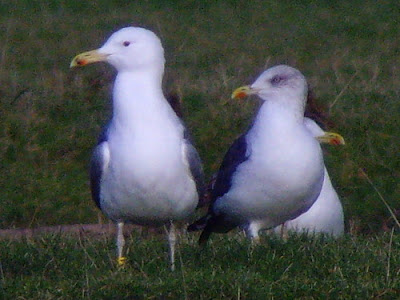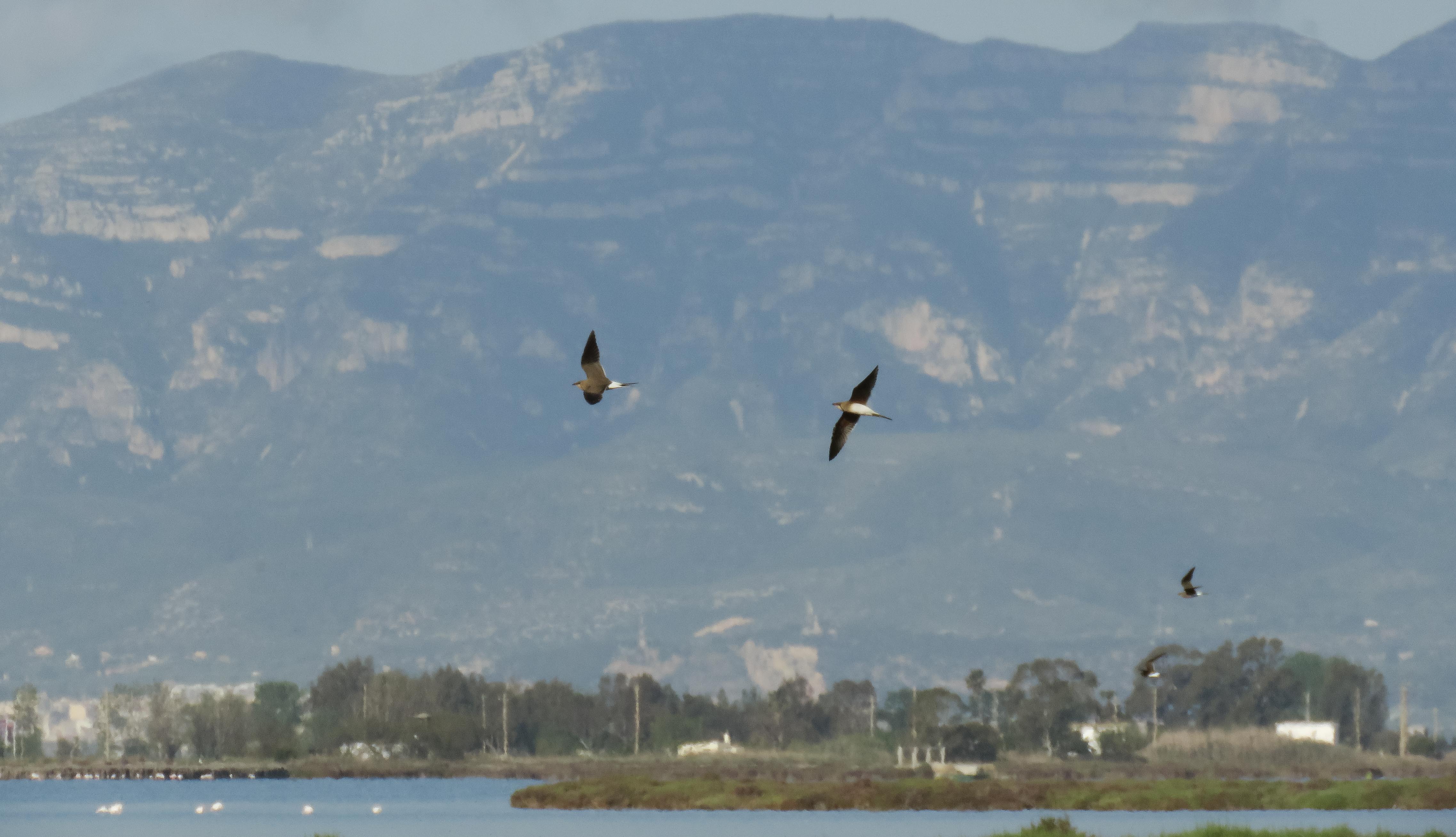Yellow-legged Gull 1 adult
Exceat Bridge
Lesser Black-backed Gull c.350
Yellow-legged Gull 1 adult
Caspian Gull 3 (2 adults and a 3w) adult male polish-ringed PEAA
Typical Caspian Gulls are often described as small-headed, rather skeletal and generally looking pear-shaped.
Typical Caspian Gulls are often described as lanky or gangly. In this pose it displays the characteristic ventral bulge of the species.
Spot the giraffe! Aptly described as a large yet elegant Gull. Easy to see why Caspian Gull has the reputation of being long-necked.
Its bill all but lacks a gonydeal angle with virtually no bulge at the gonys so appears gently tapering.
Small-looking eyes contrast with the white head. Bulging neck reminiscent of an Anaconda swallowing a Capybyra!
The unmarked gleaming white head made it difficult to overlook amongst the surrounding Lesser Black-backed Gulls even when not appearing alert when it stood literally head and shoulders above them.
Its long, thin-looking legs were striking appearing particularly noticeable in the tibia.BB106:146 notes that presumably males, can look incredibly long-legged.
Whilst its small eyes make them dark looking its irises were amber and enlargement shows they were speckled. Its eyes were encapsulated by narrow red orbital rings.
For Caspian Gull the bill is most often more than twice as long as its maximum depth, while for Herring Gull it is most frequently a little less than twice its maximum depth.Some Caspian Gulls can be extremely long- and slim-billed, with ratios up to 3.25, compared with a maximum of 2.5 in Herring Gull. Try on the above...
Viewed head-on its pin-hole eyes were the order of the day.
The bill showed an isolated dark crescent and spot in the gonys with the small red spot restricted to the lower mandible.
Its hard to imagine a more snouty individual than this by virtue of its long sloping forehead and long, slim bill.
Whilst its upperpart colour was noticeably paler than the surrounding Lesser Black-backed Gulls it appeared darker than nearby argenteus Herring Gulls but paler and less blue compared to the adult Yellow-legged Gull in the same flock.
Its greyish-flesh coloured legs appeared typically pale.
BB104:712 detailed a trait-scoring system aiding identification of Caspian Gulls. Attempting to apply objective scores to this individual yields a result of 5 falling well below the hybrid threshold of 9.
Whilst not quite side-on it is just about possible to appreciate its attenuated rear-end by virtue of its flat back, limited tertial step and relatively long wings.
Wing stretching it reveals the white tip to p10, the mirror on p9 and even the unbroken narrow black subterminal band to p5 and the extensive pale grey tongues on the inner webs of the underside of the primaries.
Not quite the so-called Albatross-posture but nice to get the idea! It nicely reveals the long white tongue on the inner web of the underside of p10, the white tongue breaking through the black band separating the tongue from the tip (being a known occasional variation for pure Caspian rather than being indicative of intrgression with Herring Gull BB103:169) and the extensive white tip with just a shadow of an incomplete subterminal band.
Colour-rings might prove the best 'field character' for some Gulls but thankfully that doesn't apply to this individual!
Whilt my camera settings were all wrong and the bird distant this flight shot does reveal its long- and broad-winged appearance and in comparison with Herring Gull the greater length of the head, bill and neck extension in front of the wings also being apparent.
No hiding that long bill even in the poorest images!
With a bit of imagination just about possible to see the grey tongues eating into the black wing-tip on the upperside of the outer primaries that was readily seen in the field as it wing-stretched.
Polish-ringed adult male Caspian Gull at Exceat Bridge
Map showing original ringing location in Poland on 19/4/11, where the ring was read in the Netherlands on 1/8/11 and Exceat Bridge on 16/12/12. The Polish Caspian Gull breeding colony where it was ringed falls to the south of the approximate hybrid zone mapped in BB104:12:705.
We are very grateful to Grzegorz Neubauer (coincidentally one of the co-authors of Identification of Caspian Gull Part 2 BB104:12:702-742) and the Polish Bird Ringing Centre who replied by return 'nice Caspian Gull Larus cachinnans, ringed as a male at a Caspian Gull breeding colony at Żwirownia Zakole A, Jankowice, Babice, Malopolskie, Poland by Jacek Betlega on the 19/4/11 and subsequently seen at Wessem in the Netherlands on the 1/8/11 and at nearby Maasbracht, Bunkerhaven on 11/8/11 and 25/8/11 by Jeroen Nagtegaal.
Map showing original ringing location in Poland on 19/4/11, where the ring was read in the Netherlands on 1/8/11 and Exceat Bridge on 16/12/12. The Polish Caspian Gull breeding colony where it was ringed falls to the south of the approximate hybrid zone mapped in BB104:12:705.
Third-winter Caspian Gull at Exceat Bridge
Initially stood alongside the ringed adult its size and structure appeared identical so presumably another male sharing similar long- (especially in the tibia) and thin-legs being identically pale greyish-flesh coloured in appearance. Its long slim gently-tapering bill basally had an obvious cutting edge extending onto its face as an obvious gape-line and was noticeably duller than the adults being a limey greenish-yellow with a darker subterminal band at the gonys. It also shared its small clean white skeletal pear-shaped head with long 'never-ending' lores, pin-hole dark-looking small eyes complete with Albatross-like greyish furrowed-brows! Its lower rear nape was peppered by some dark spots. Its mantle was an unmarked grey appearing identical in hue to the accompanying adult. A few of its faded upperwing coverts retained their dark centres as did a tertial all of which were white-tipped forming an obvious tertial crescent. Its primaries were black and long. Prior to flying it adopted a long-necked giraffe-like posture.
Initially stood alongside the ringed adult its size and structure appeared identical so presumably another male sharing similar long- (especially in the tibia) and thin-legs being identically pale greyish-flesh coloured in appearance. Its long slim gently-tapering bill basally had an obvious cutting edge extending onto its face as an obvious gape-line and was noticeably duller than the adults being a limey greenish-yellow with a darker subterminal band at the gonys. It also shared its small clean white skeletal pear-shaped head with long 'never-ending' lores, pin-hole dark-looking small eyes complete with Albatross-like greyish furrowed-brows! Its lower rear nape was peppered by some dark spots. Its mantle was an unmarked grey appearing identical in hue to the accompanying adult. A few of its faded upperwing coverts retained their dark centres as did a tertial all of which were white-tipped forming an obvious tertial crescent. Its primaries were black and long. Prior to flying it adopted a long-necked giraffe-like posture.
Unringed adult Caspian Gull at Exceat Bridge
Another fine adult was present in the same flock, although in contrast to the ringed individual, this one seemed intent on sitting down and sleeping at every opportunity. Whilst flatter-crowned its overall size and structure appeared very similar to the ringed adult present so presumably another male. Note its pure white head with long sloping forehead, 'never-ending' lores, small dark-looking but actually amber-coloured eyes, grey brows, long slim bill complete with obvious cutting edge basally, restricted black spot and red restricted to its lower mandible. In the image of it walking, almost as if on tiptoes, the grey hue of its upperparts appears uniform and darker than argenteus, its flat back is striking, its ventral bulge is just visible as are its long pale greyish fleshy slightly ochre-tinted legs - long tibia again readily apparent. It appeared long-winged with obvious white tips to p10.
Another fine adult was present in the same flock, although in contrast to the ringed individual, this one seemed intent on sitting down and sleeping at every opportunity. Whilst flatter-crowned its overall size and structure appeared very similar to the ringed adult present so presumably another male. Note its pure white head with long sloping forehead, 'never-ending' lores, small dark-looking but actually amber-coloured eyes, grey brows, long slim bill complete with obvious cutting edge basally, restricted black spot and red restricted to its lower mandible. In the image of it walking, almost as if on tiptoes, the grey hue of its upperparts appears uniform and darker than argenteus, its flat back is striking, its ventral bulge is just visible as are its long pale greyish fleshy slightly ochre-tinted legs - long tibia again readily apparent. It appeared long-winged with obvious white tips to p10.






































